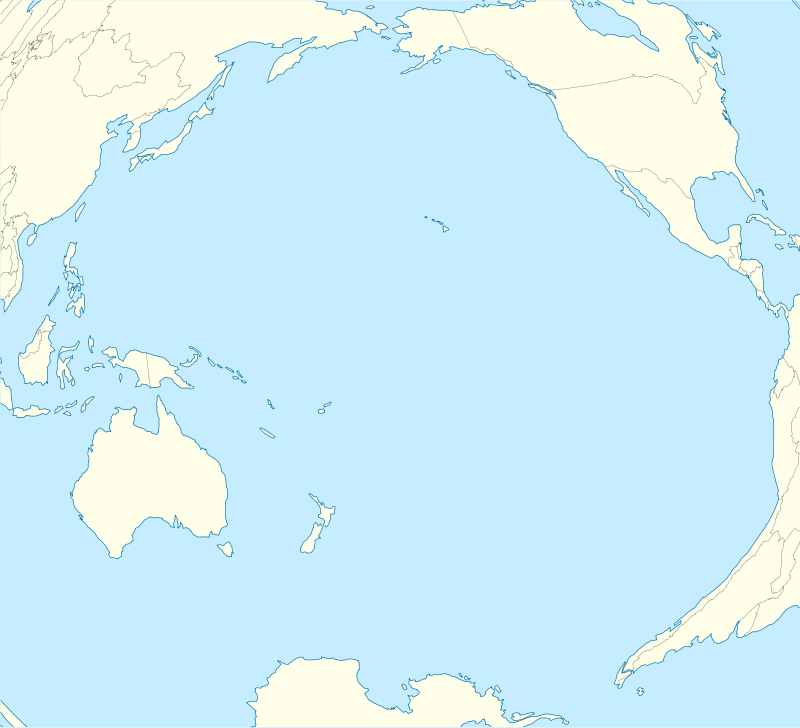Ontong Java Plateau

The Ontong Java Plateau is a huge oceanic plateau located in the Pacific Ocean, lying north of the Solomon Islands. The plateau covers an area of approximately 2,000,000 km2 (770,000 sq mi), or roughly the size of Alaska, and reaches a thickness of up to 30 km (19 mi). The plateau is of volcanic origin, composed mostly of flood basalts. Although they are now separated by thousands of kilometres, Manihiki Plateau and Hikurangi Plateau were at the time of their origin part of the same large igneous province, forming the world's largest oceanic plateau. It extruded some 100 million km3 of magma, covering approximately 1% of the Earth's surface, in one of the largest volcanic events on Earth in the last 300 million years.[1][2]
The Ontong Java Plateau was formed 125–120 million years ago possibly by the initial plume-head phase of a mantle plume center called the Louisville hotspot.[3] The timing corresponds roughly to the early Aptian anoxic event in the oceans.
Most of the rocks that make up the plateaus have been dated to 125–119 million years ago, in the Lower Cretaceous Epoch, with some secondary volcanism occurring 20–40 million years later, in the Upper Cretaceous Epoch.
These plateaus were formed beneath the waters of the Pacific Ocean, and mostly still lie under the sea—although the collision of the Solomon Islands with the Ontong Java Plateau has lifted some of this plateau above sea level on the islands of Makira, Malaita, and the northern half of Santa Isabel, and the smaller islands of Ramos and Ulawa. Several large seamounts arise from the plateau, including the one capped by Ontong Java Atoll.
References
- ↑ "the Manihiki and Hikurangi Plateaus [...] we interpret as remnants of a formerly contiguous Ontong Java–Manihiki–Hikurangi large igneous province". Tim J. Worthington; Roger Hekinian; Peter Stoffers; Thomas Kuhn; Folkmar Hauff (30 May 2006). "Osbourn Trough: Structure, geochemistry and implications of a mid-Cretaceous paleospreading ridge in the South Pacific". Earth and Planetary Science Letters. 245 (3–4): 685–701. Bibcode:2006E&PSL.245..685W. doi:10.1016/j.epsl.2006.03.018. Retrieved 2007-03-14.
- ↑ Brian Taylor (31 January 2006). "The single largest oceanic plateau: Ontong Java-Manihiki-Hikurangi". Earth and Planetary Science Letters. 241 (3–4): 372–380. Bibcode:2006E&PSL.241..372T. doi:10.1016/j.epsl.2005.11.049. Retrieved 2007-05-22. Summary.
- ↑ Antretter, M.; Riisager, P.; Hall, S.; Zhao, X.; and Steinberger, B. (2004). Modelled palaeolatitudes for the Louisville hot spot and the Ontong Java Plateau, in Origin and Evolution of the Ontong Java Plateau Geological Society, London, Special Publications, v. 229, p. 21-30. doi:10.1144/GSL.SP.2004.229.01.03.
Further reading
- J. G. Fitton; J. J. Mahoney; P. J. Wallace; A. D. Saunders, eds. (2004). Origin & Evolution of the Ontong Java Plateau. Special Publication 229. Geological Society. ISBN 978-1-86239-157-4.
External links
- Large Igneous Provinces: Ontong Java Plateau, by Clive Neal, University of Notre Dame
- Fitton, J.G., Mahoney, J.J., Wallace, P.J., and Saunders, A.D. (Eds.) (2004). "Volume 192 Scientific Results". Proceedings of the Ocean Drilling Program. Ocean Drilling Program. 192. doi:10.2973/odp.proc.sr.192.2004. ISSN 1096-7451.
Coordinates: 3°03′S 160°23′E / 3.050°S 160.383°E